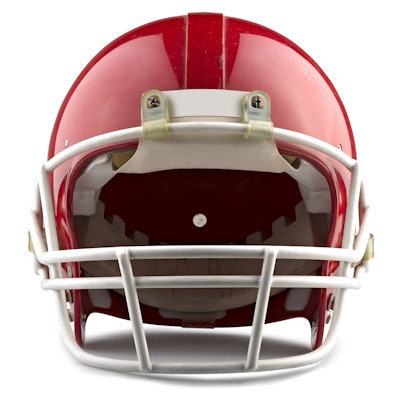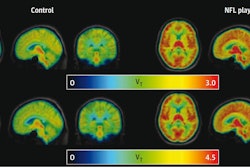
CT scans show that some former NFL players had considerably wider aortas than a random sample of men drawn from a Texas community, even after adjusting for known risk factors, according to a study published in the November issue of Circulation: Cardiovascular Imaging.
In the cross-sectional study, researchers used CT scans to compare the aortic dimensions of hundreds of retired NFL athletes with those of men participating in the Dallas Heart Study 2 (DHS-2). The CT scans indicated that the football players had significantly larger diameters of the ascending aorta, and many of the widths exceeded the benchmark of 4 cm that would indicate aortic dilation.
The results could mean that physicians may consider surgical intervention before potentially catastrophic consequences of a dilated or weakened aorta arise, co-author Dr. Parag Joshi from the University of Texas Southwestern Medical Center told AuntMinnie.com (Circ Cardiovasc Imaging, November 2017, Vol. 10:11).
"What was striking was that nearly 30% of the former NFL players had an aortic diameter greater than 4 cm -- a sign there's potential weakening of the aortic wall that can lead to a tear, if it continues to get bigger," he said. "That's our threshold for saying, 'We need to follow this a little more closely.' "
When bigger isn't better
Intense, consistent exercise often prompts the heart to engage in gradual structural and functional adaptations that result in "athlete's heart," according to the authors, who also came from the Cleveland Clinic and Johns Hopkins. Prior research has shown football players to be particularly susceptible to concentric hypertrophy, which, in turn, alters the aorta's elastic properties and ultimately enlarges it.
Taking into account the propensity of the aorta to continue growing, the investigators in the current study sought to assess the long-term effect of intense resistance training on the aortic dimensions of NFL players.
"The main question was: What happens to the size of the aorta after years of elite strength training?" Joshi said. "And then how do we contextualize it?"
At the Cleveland Clinic, 206 former NFL players underwent noncontrast CT scans with a slice thickness of 3 mm. The researchers measured the ascending aorta in these scans and compared the results with the aortic dimensions of 759 men from the DHS-2. This Dallas control group was comparable to the NFL cohort in terms of several key characteristics, including age, race, body surface area, and body mass index (BMI).
Evaluation of the data revealed a significantly larger aortic diameter in the former football players than in the control group.
| CT aortic measurements of football players vs. nonathlete men | ||
| Dallas Heart Study 2 | Former NFL players | |
| Mean aortic diameter (mm) | 34 | 38 |
| Aortic diameter > 40 mm | 8.6% | 29.6% |
The pattern of larger aortas in former football players held true independent of many fundamental variables: age, race, systolic blood pressure, body surface area, smoking, cholesterol level, diabetes mellitus, and history of hypertension.
"Bigger people have bigger aortas, but even after adjusting for the size of the players and other risk factors that can lead to a dilated aorta, we still saw that NFL players were two times as likely to have a dilated aorta," Joshi said.
What factors matter most?
Further analysis of the data pointed to several independent predictors of having an ascending aortic diameter greater than 4 cm, including being a former NFL player (odds ratio, 1.99; p = 0.014), age, body surface area, and high-density lipoprotein (HDL) cholesterol.
 Dr. Parag Joshi from University of Texas Southwestern Medical Center.
Dr. Parag Joshi from University of Texas Southwestern Medical Center.The researchers also noted that 9% of the ex-NFL players had an aorta at least 4.5 cm in size, which is the recommended cutoff measurement for replacement of the aorta in patients requiring cardiac surgery, according to the researchers. A few of the players' aortas almost reached the 5.5-cm mark, at which point physicians strongly recommend preventative surgery.
Most of these highly dilated aortas belonged to linemen and linebackers. Though the difference was not statistically significant (p < 0.093), the researchers spotted a larger mean ascending aortic diameter in linemen and linebackers (3.9 cm) compared with players of other positions (3.7 cm).
"It's important as we go forward to understand what types of exercises put these players at risk," lead author Dr. James Gentry of the Cleveland Clinic said. "Considering it was the linemen [and linebackers] who maintained larger aortas after controlling for various factors, it'd be interesting to compare individuals like linemen who are doing resistance training versus those whose primary focus is endurance training."
The findings led the authors to point out a salient limitation of the study: not knowing whether the degree of aortic widening they saw has consequences in terms of additional aortic complications or if it could lead to health risks later in life.
Other studies have speculated as to what factors contribute to aortic dilation in retired NFL players. Iskandar et al suggested that athletes may develop slight aortic enlargement during their playing days and then continue along the normal age-related growth curve from there on out.
"Younger athletes have slightly larger aortas than other people their age," Gentry said. "So is it that the aortas get larger at a younger age and then maintain normal growth, or is it that the aorta continues to grow exponentially well into middle age? If you're able to look at these individuals prospectively, you'd be able to find out when this aortic dilation happens, as well as if and when it puts them at risk for aortic dissection."
What does bigger portend?
In an accompanying editorial, physicians from Massachusetts General Hospital noted a lengthy gap in time between when players retired from the NFL (typically by the age of 35) and their mean age in the current study (57 years). The players' continued participation in high-intensity static and dynamic physical activity, as well as obesity, disordered sleep breathing, and untreated injuries acquired during their playing careers, could explain their postretirement aortic dilation, according to Dr. Timothy Churchill and Dr. Aaron Baggish.
"It remains possible if not probable that the interceding postcareer decades play an important role in contributing to aortic dilation," they wrote. "Alternatively, perhaps mild to moderate aortic dilation among highly active people and competitive athletes represents a relatively benign phenotype."
For now, the part of the equation that explains what happens to the players after they finish playing and the potential for future health risks is still unclear, Joshi said.
"So the next question that needs to be answered is: What happens to these athletes, and is there any sign that indicates higher rates of tear in the aorta?" he said. "This should prompt the NFL or the player's association or other research groups to follow players over time to see what happens to them."




















